Cowabunga in Guadeloupe
by
James Ewing
After you’ve been out cruising for a long time – say two weeks – you become aware that there are Rules. Not Red-Right-Returning kind of rules but Thou Shalt Not…. kind of Rules. Some of these Rules like: When you want to varnish, it will rain merely serve to show that the Celestial Cupcake responsible for the Rules has a sense of humor. Resplendent in Its icing the Frosted Rule Maker is really just messing with your head. Sure,Its thoughts travel to you as you tremble under a menacing gray sky, just pop the top on that can of Schooner. It’ll be OK…. You trust in Its beneficence, open the can, and watch as the gray clouds are swept away on a 30 knot breeze. HaHaHa! But boats do – eventually – get varnished and painted, etc. so the rule is not inviolate.
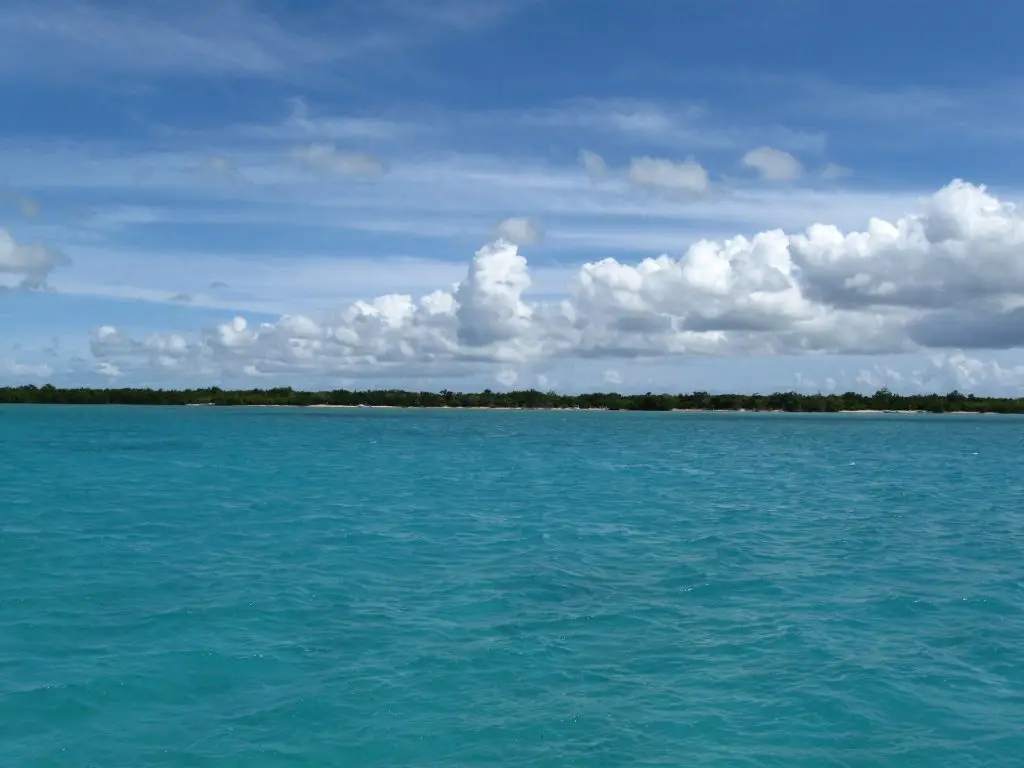
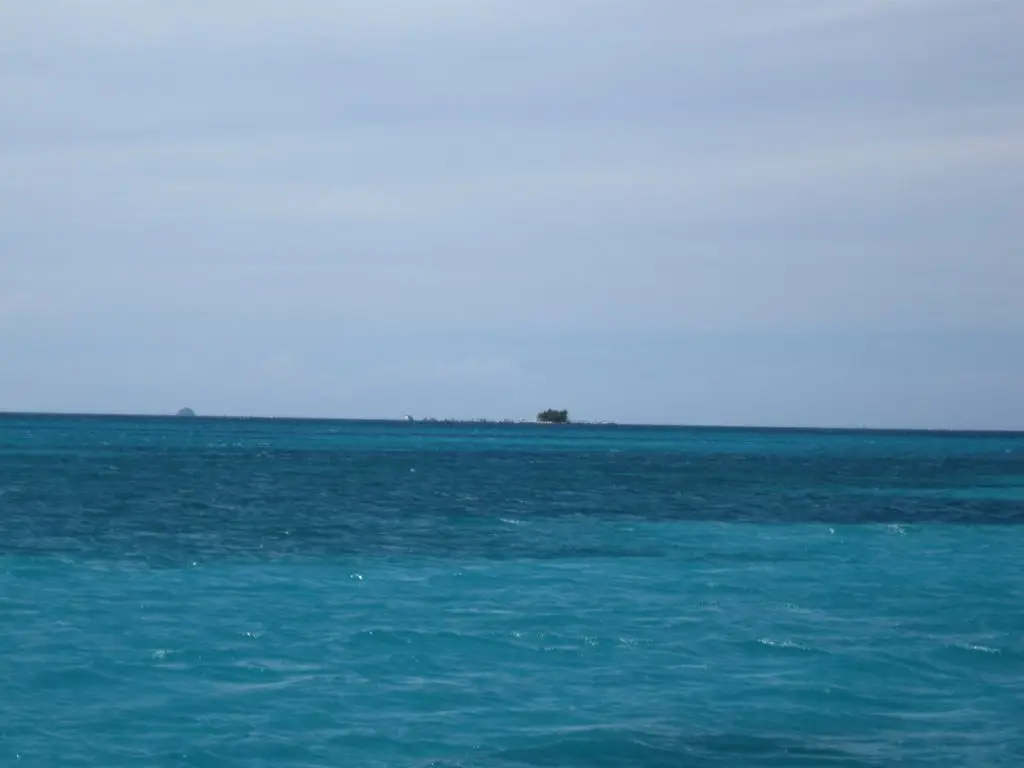
Some other Rules, however, were carved into the very Fabric of Space and Time when the Omnipotent Baked-Good first issued forth from the Stellar Oven. Two of these Rules form the foundation of this story. The first is one of the simplest. It is RULE 1 and states – Today, you will never know what will happen tomorrow. The second, I am proud to say, is titled Ewing’s Second Restatement of Murphy’s Law. It reads: The weirdest thing that can possibly happen, will. And on this spitty, blowy, gray Tuesday – putting the keebash on any hope of varnishing – both of these Rules were in full effect.
That Monday evening we were sitting comfortably behind Ilet á Fajou tucked inside the barrier reef just north of the island of Guadeloupe in the Eastern Caribbean. We had a favorable weather report – Rules 1, 17, 23 – for moderate easterly winds of 15 knots and we expected a light chop in the protected waters behind the reef. There was no call for rain. Perfect, Ann and I thought, for taking Bees Knees, our Creekmore designed cutter, down for some exploration of ‘La Grande Riviere á Goyaves’. Only the French could make ‘Big Guava River’ sound so – French. The Guidebook promised a picturesque dinghy trip up, what was billed as, The Longest Navigable River in the Eastern Caribbean. It mentioned interesting foliage, beautiful views of the mountains of Guadeloupe, exotic birds, and cows.
That, we realize now, was our first warning.
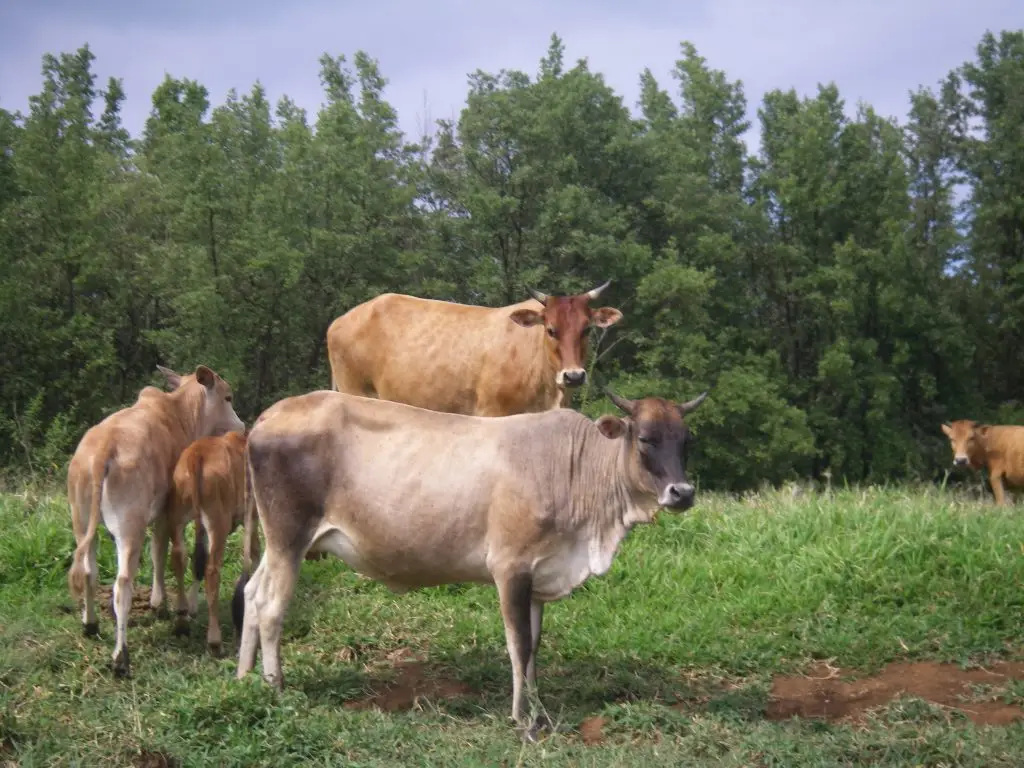
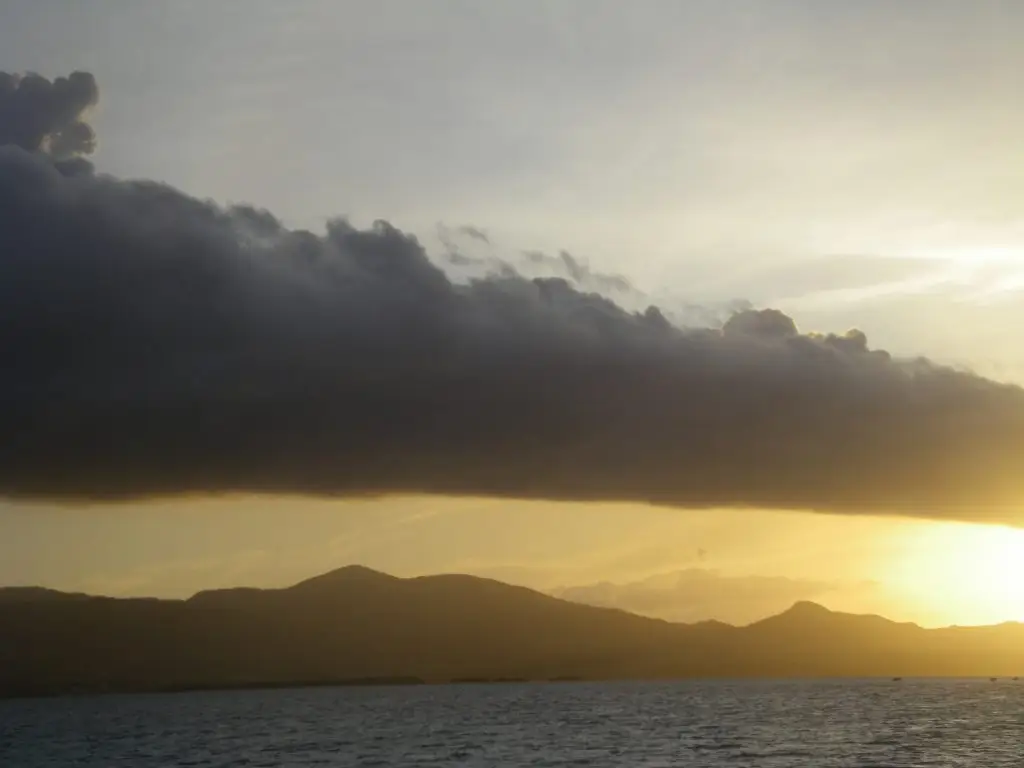
Tuesday morning we woke, as expected, to a 20 knot wind pushing low, scudding rain clouds. It was never a heavy rain, just enough to keep the varnish in the can. But we weren’t in any hurry so we relaxed until the clouds passed through. About noon we were ready to go. We picked up the anchor, it began to rain again – Rule 19 – and the wind jumped up a few knots to 22 gusting 25 – Rule 21. Off we went. It was only a few miles but it was directly into the wind – Rule 2. So we motored.
The anchorage at the river is an open roadstead exposed to the east. The increasing easterly winds had built up a nice little two-foot breaking chop leaving a shallow rocky shoal as the most likely destination upon dragging – Rule 12. We scanned the chart and found another tiny shoal outside the anchorage area but a little closer to the river. We went over and checked it out – just mangroves downwind here – and the shoal did manage to break the chop a little.
Down goes the anchor in about 14 feet, out goes the chain and off we sail towards the mangroves. Let’s try getting closer. So we scoot into 12 feet – close enough to see the rocks approaching the surface through the murky river water. Again, down goes the anchor, out goes the chain, the hook sets, skips, and off we go heading for the trees. Then we had the conversation: Is it worth it? I don’t know. Should we try again? OK! This time Ann picked out a slightly lighter patch in deeper water. Bingo! The hook set and stayed, we backed down on it, hopped in the dinghy and headed off to the Big Guava River.
We crossed the bar at the mouth of the river and could barely see the bottom a mere foot away through the opaque, tannin-stained water. The Guidebook warned not to swim in the water due to a danger of Bilharzia. We couldn’t find out who or what that was but we sure weren’t going to touch the water and risk its wrath – Rule 5. We entered the mangroves and the river opened up before us. It was as promised. Verdant stands of bamboo dipped into the water along the banks. Trees filled with bright, colorful flowers lined the shores. Mats of water plants festooned with bright blue blossoms crowded the edge of the river. Birds flew overhead or fished the shallows. And everywhere you looked, around every bend, were cows. Little cows, big cows, she cows, he cows it was like a page out of Dr. Seuss. Some of the cows had an accompanying Cattle Egret picking off the bugs the cows stirred up. Some just stood and stared. These were not your cute little Elsie the Cow from the golden age of advertising. These were all horns, hooves and a steely glare that could freeze you in your tracks. Yes, my little entrecote de la grande isle, these cows were all destined for market. Beef, it seems, is a big deal on Guadeloupe.
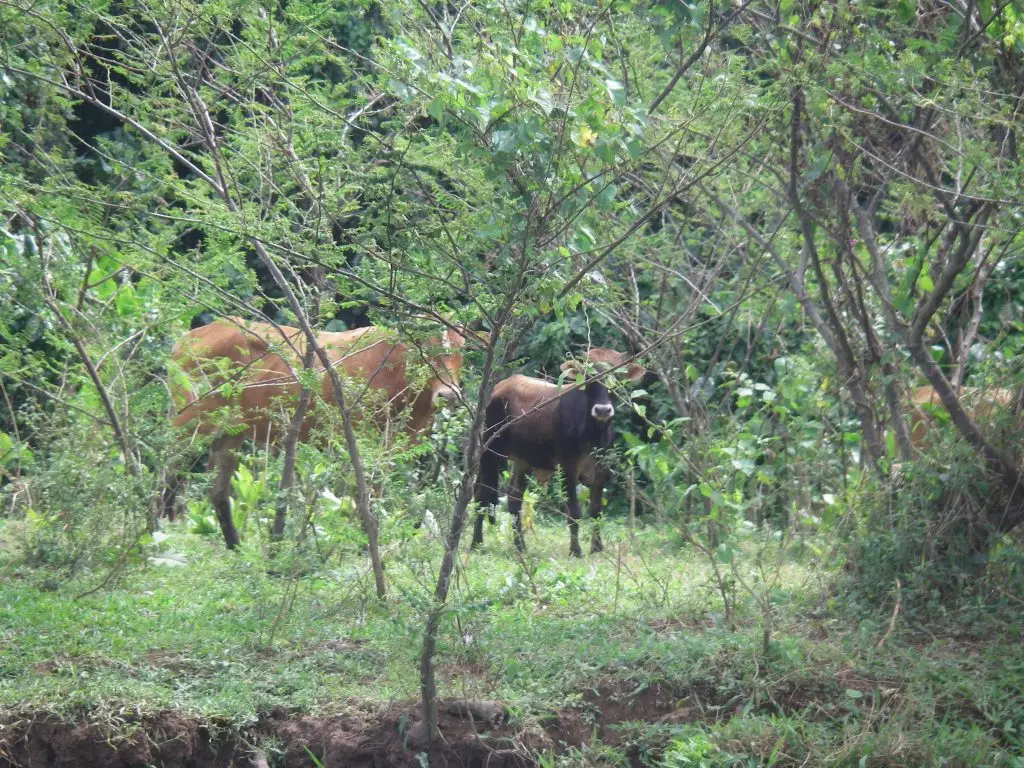
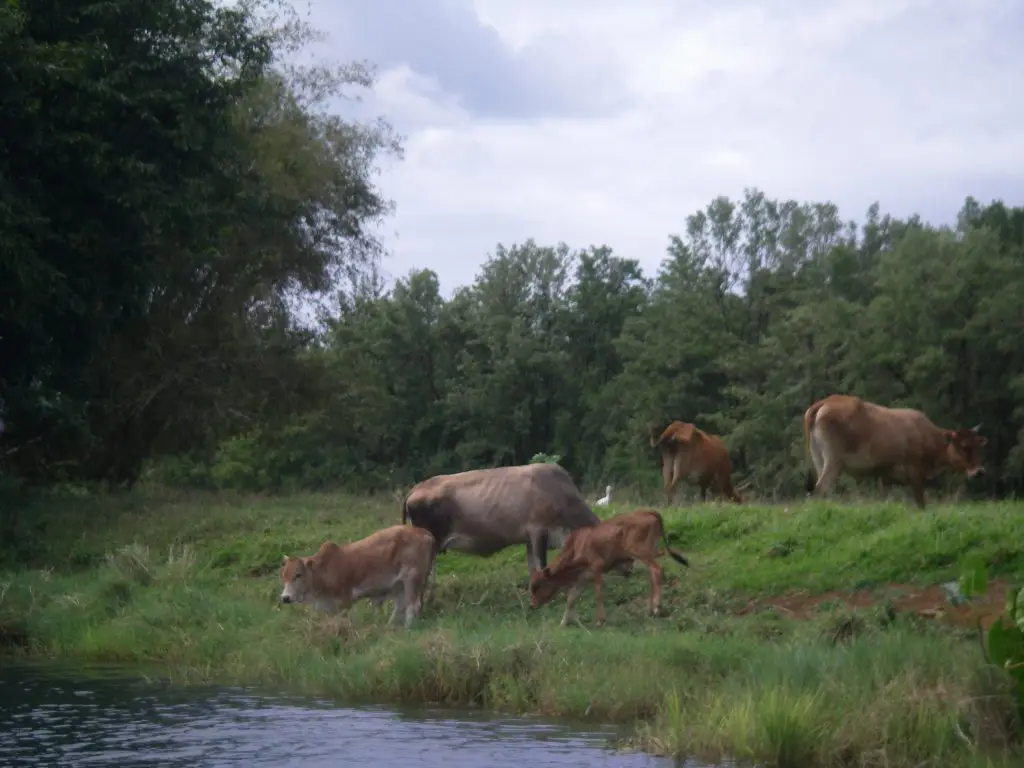
The people of the Eastern Caribbean are, by-and-large, among the friendliest in the world. Guadeloupe is no exception. Along the banks we encountered fishermen, farmers, people tending the cattle. Everybody waved at us like we were the first people they’d seen today. One pair – they looked like a farmer and his young son – were particularly effusive. Hey, did they just wave us over. I think so. Probably just wanted to say Hi or give us a tour of their farm. On we motored unaware of who they were or what they wanted. That would soon change.
We ran up the river for about another two miles. I checked the gas and it was getting low. The river was only navigable for a bit further so we turned the dinghy around and headed downstream. Many of the same people were there – everybody waved again. We came zipping around a bend and there, waving and beckoning, were the farmer and his son. They were pointing across the river at a stand of bamboo.
Ann saw it first. Stuck in the bamboo, only horns and nostrils above the water, was a cow. Since we saw them last it looked as if they had constructed a bamboo trestle that extended about eight feet out into the river. Boy, did we feel bad about not stopping on the way up.
I studied French in high school. Most of it remained behind in my locker. But my French teacher was from the Paris of World War One and was very particular about her students’ grammar and pronunciation. Those lessons die hard so I can still say “I don’t speak any French” in almost flawless French. We motored over to the farmer and he proceeded to explain their predicament. I did my “I don’t speak any French” trick and he looked at me like I was nuts. He said “Ah, no French” in that insouciant way that only the French can and spoke not another word. He signaled that he wanted to go to the cow. We signed for him to get in the dinghy. He picked up his razor-edged machete, casually whacked off a green branch leaving a javelin-sharp point on one end and handed these implements of our demise down to Ann in our inflatable dinghy. This was the first time I wondered how well we would float with all the air out of the tubes. He then asked, I kid you not, in sign language, for permission to come aboard. He grabbed a long rope, hopped in and off we went.
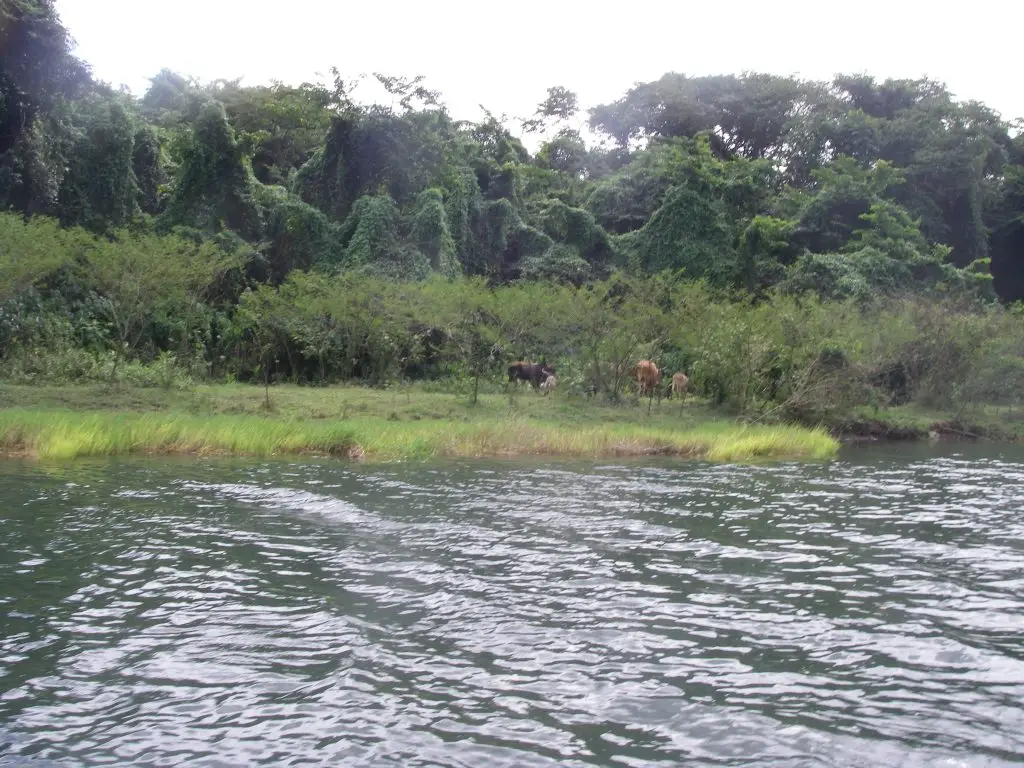
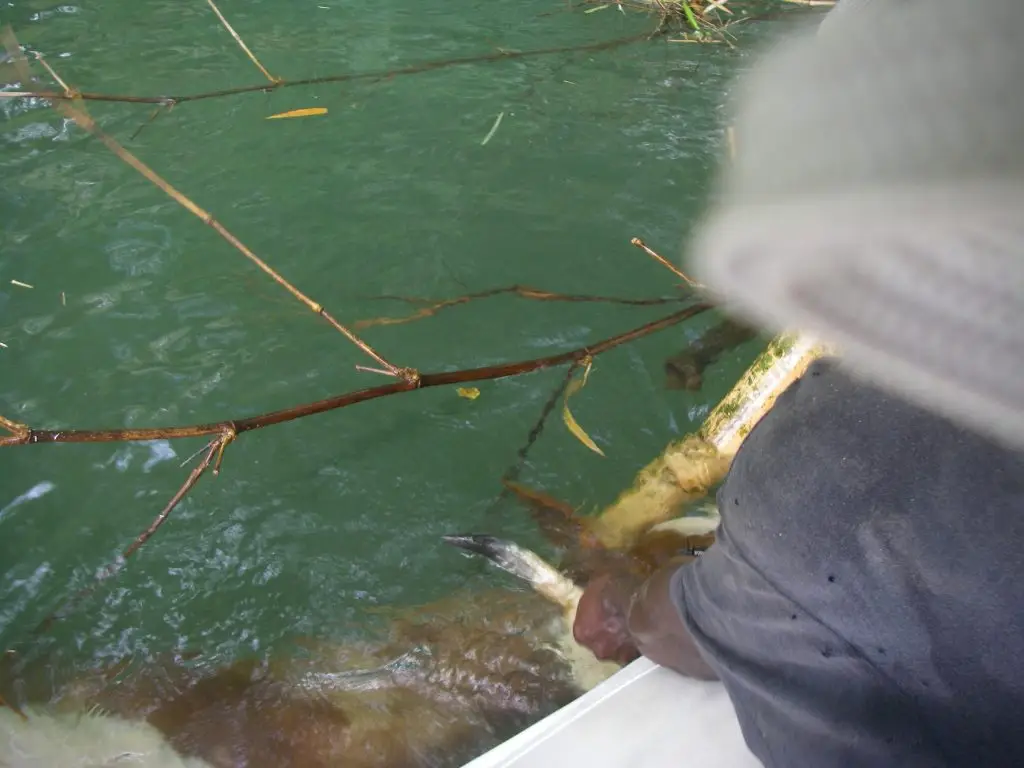
The river here was only about 100 feet wide. We easily crossed and wedged the inflatable dinghy into the tangle of shattered bamboo. That was the second time I feared for our air. We were just upstream of the cow. The cow, though stuck and stuck good, was not in any danger. While not aquatic creatures they are nonetheless very gaseous creatures. The cow floated calmly alongside the dinghy while the farmer surveyed its predicament. It looked like the tether the cow had been tied up with had wrapped around the bamboo deep in the murky, bilharzia – whatever that is – infested water. The farmer fashioned a loop in the rope he brought, hooked it over the beast’s horns and pulled the dinghy and cow’s horns tight together. That was the third time I thought we would deflate.
Thinking quickly, I handed Ann the camera and said “Take pictures.” She started but then the farmer picked up his machete and lowered it down onto the cow’s forehead. Ann is a nurse, and a vegetarian. She is not bothered by the sight of blood or much else. But this might be cow blood. She retired to the bow and steadied us in the bamboo. I reached down to hold the cow’s head steady but the farmer didn’t have a good angle for his cut. The proximity of my hands to his machete made me realize that I might not be able to count to ten by the time he was done. I let go. He grabbed the stuck tether where it crossed the cow’s head, brought his blade down, and started cutting. The cow must have known it was OK. It didn’t struggle, the farmer cut smoothly through the tether, and all the air remained in the dinghy. The cow was free.
I learned how wrong I was. Cows are indeed fully aquatic animals. As soon as it got unstuck it struck off across the river in high gear. It was such an effective swimmer that it easily pulled the dinghy, three adults and the fifteen-horsepower motor that was trying to turn it all the way back across the river to the landing spot it had chosen. The farmer wanted me to steer downstream to a gently sloped bank but the cow would have none of it. It hauled itself into shallow water and stopped there with no intention of moving.
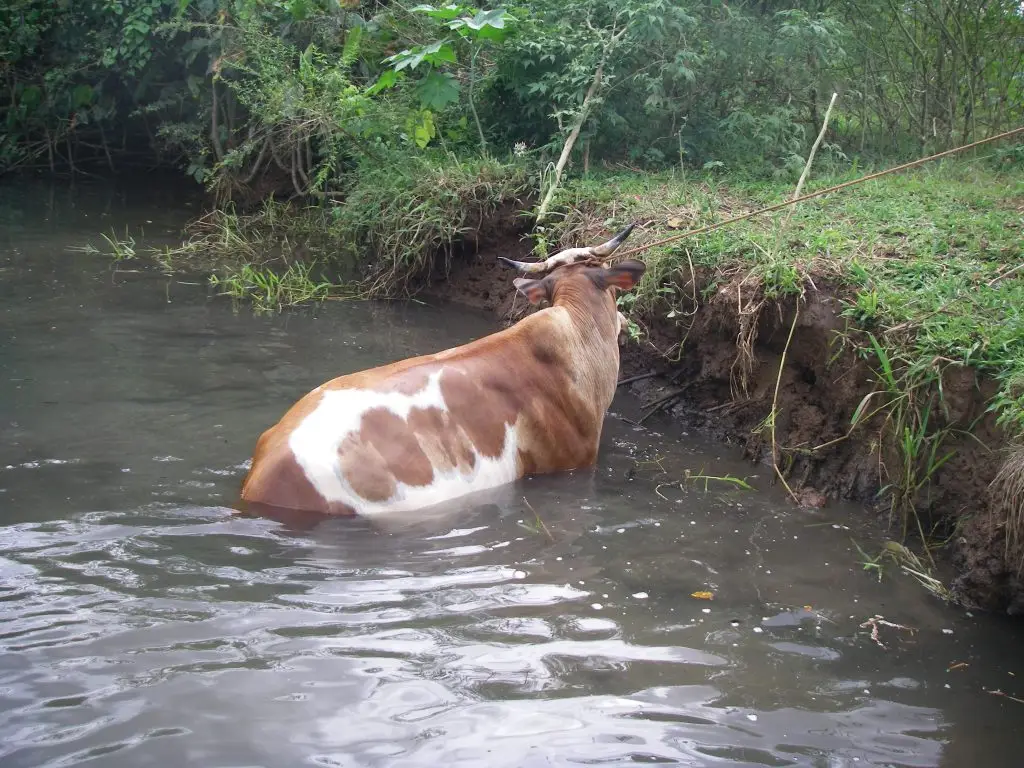
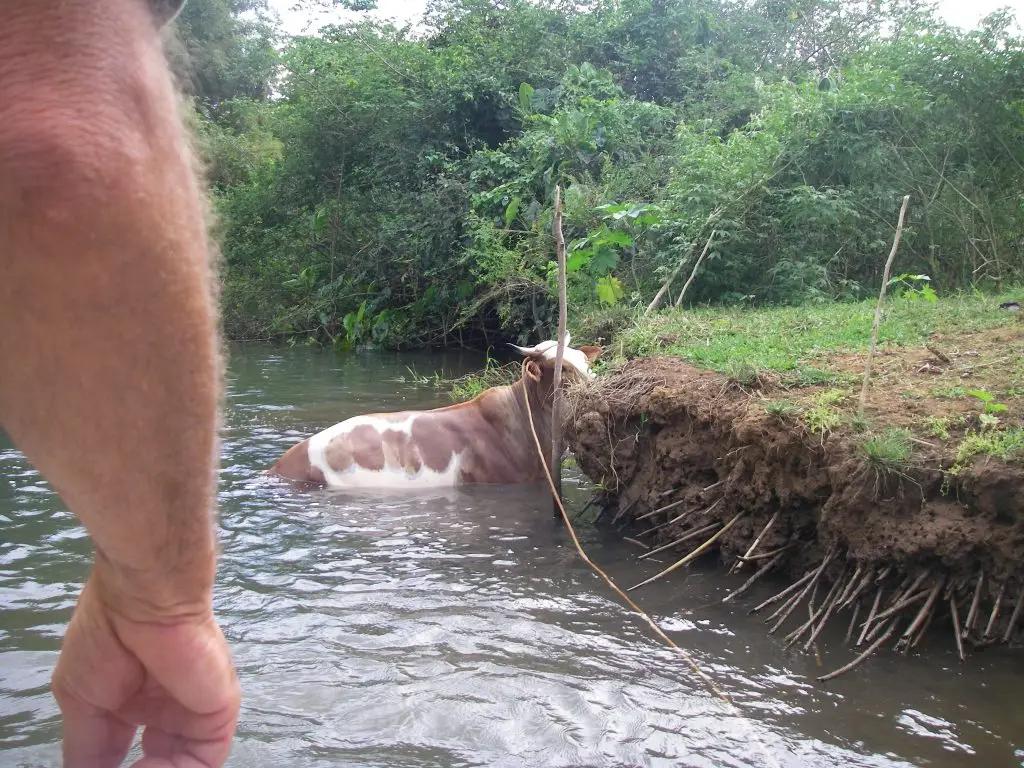
The farmer tried pulling it back into the water. He got out onto the bank and tried pulling it up the bank. I tried going upstream of the cow and giving it an encouraging nudge with the dinghy. The farmer got back into the dinghy and we tried pulling it off the bank. Nothing worked. Finally, I gave a beckoning thump on the side of the dinghy and said something stupid like “Come cow.” The cow, I kid you not, jumped back into the water, swam down the river to the easier exit and stumbled up the bank onto dry land. The farmer followed, turned and waved to us, then walked off after his cow. We sat quietly in the dinghy for a few moments reflecting on the day’s events but mostly listening for the hissing of escaping air. Then we turned downstream heading back to Bees Knees. Ann’s a vegetarian. I am not. But that night I did pass on the cheeseburger for dinner.
That’s the way it goes when you’re out here cruising. There truly are Rules and as long as you follow them, or let them lead you, it really is just one adventure after another. Expect the unexpected but figure it’s going to be much more unexpected than you imagined.
